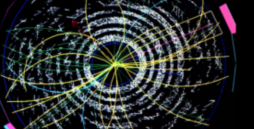Mr
Benjamin Schlitzer
(UC Davis)
05/06/2017, 13:30
Oral Presentation
One of the unique challenges facing direct dark matter searches is the signal characterization of the dark matter particle with the detector medium. The goal of the Argon Recoil Ionization and Scintillation (ARIS) experiment is to characterize the response of nuclear recoils in liquid argon (as expected from WIMPs) by measuring the energy scale of nuclear recoils with respect to electron...
Ting Li
(Fermilab)
05/06/2017, 13:45
Oral Presentation
The census of Milky Way satellite galaxies provides crucial tests of both galaxy formation models and the broader Cold Dark Matter paradigm. A total of 27 new Milky Way satellite candidates have been discovered in the last two years, primarily in data from the Dark Energy Survey. These discoveries may represent a 100% increase in the number of known Milky Way satellite galaxies, leading a huge...
Dr
Brian Nord
(Fermilab)
05/06/2017, 14:00
Oral Presentation
Current and future cosmology surveys will provide data sets unprecedented in size and precision with which to measure dark energy, dark matter and the early universe through probes like strong gravitational lensing, supernovae, and the cosmic microwave background. First, we’ll discuss the challenges posed by astronomically big and complex data, and the potential for machine learning. Then, I...
Ross Cawthon
(University of Chicago)
05/06/2017, 14:15
Oral Presentation
Redshift estimation is among the most significant issues in photometric cosmological surveys. Undetected biases in photometric redshift estimation can be found using clustering redshifts. In this presentation, we describe our clustering redshift estimates for weak lensing source galaxies, and redMaGiC galaxies in the Dark Energy Survey year 1 data. We also describe our methodology of applying...
Ms
Qing Yang Tang
(University of Chicago)
05/06/2017, 14:30
Oral Presentation
Microwave Kinetic Inductance Detectors (MKIDs) have become an attractive alternative to traditional Transition Edge Sensor (TES) bolometers in the sub-mm and mm observing community due to its innate frequency multiplexing capabilities and simple lithographic processes. These advantages make MKIDs a viable option for the O(100,000) detectors needed for the upcoming Cosmic Microwave Background -...
Mr
Daniel George
(University of Illinois at Urbana Champaign)
05/06/2017, 14:45
Oral Presentation
We developed a new method for end-to-end time-series signal processing, based on deep convolutional neural networks, which can rapidly identify and extract signals much weaker than the background noise. We applied this method for analyzing gravitational waves from mergers of black holes and demonstrated that it significantly outperforms conventional machine learning techniques, is far more...
Mr
Karthik Ramanathan
(University of Chicago)
05/06/2017, 15:00
Oral Presentation
We report results of low-energy Compton scattering calibration studies in Silicon undertaken under the umbrella of the DAMIC (Dark Matter in CCDs) experiment. We expose a calibration detector at the University of Chicago to Co-57 and Am-241 gamma-ray sources and measure and characterize the resultant spectrum. We identify several theoretically motivated, but heretofore unobserved in the...
Mr
Vadim Semenov
(The University of Chicago)
05/06/2017, 15:15
Oral Presentation
[https://arxiv.org/abs/1704.04239]
We present a physical model that elucidates why gas depletion times in galaxies are long compared to the time scales of the processes driving the evolution of the interstellar medium. We show that global depletion times are not set by any "bottleneck" in the process of gas evolution towards the star-forming state. Instead, depletion times are long because...
